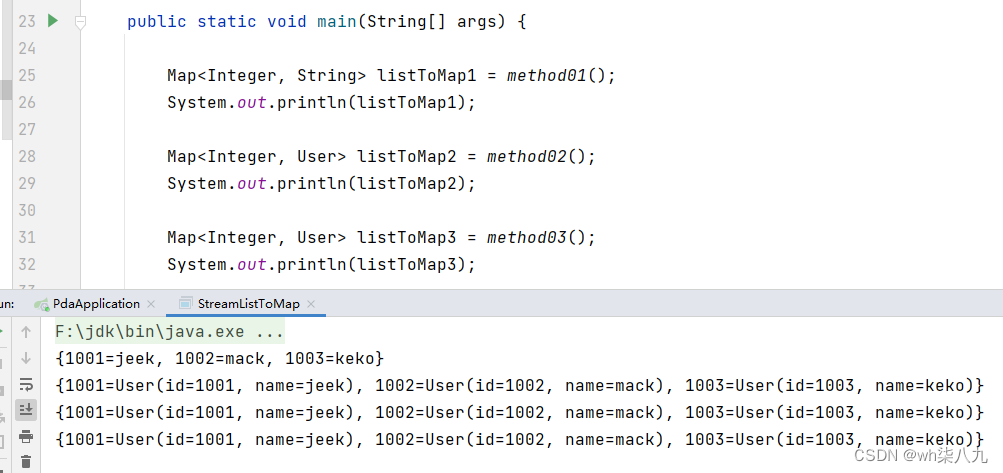本文来说下Stream实现List和Map互转总结
文章目录
- 实体类
- Map转List代码
- List转Map代码
实体类
本篇介绍Stream流List和Map互转,同时在转换过程中遇到的问题分析。
package cn.wideth.collect;import lombok.AllArgsConstructor;
import lombok.Data;
import lombok.NoArgsConstructor;@Data
@NoArgsConstructor
@AllArgsConstructor
public class User {private Integer id;private String name;}
Map转List代码
Map转List代码
package cn.wideth.collect;import lombok.extern.slf4j.Slf4j;import java.util.*;
import java.util.stream.Collectors;@Slf4j
public class StreamMapToList {/*** 数据初始化*/private static final Map<Integer, String> mapToList;static{mapToList = new HashMap<Integer, String>();mapToList.put(10088, "ccc");mapToList.put(10086, "aaa");mapToList.put(10087, "bbb");}public static void main(String[] args) {List<User> userList = defaultOrder();System.out.println(userList);List<User> userList2and = orderByKeyMethodOne();System.out.println(userList2and);List<User> userList3and = orderByKeyMethodTwo();System.out.println(userList3and);List<User> userList4and = reverseOrderByKey();System.out.println(userList4and);List<User> userList5and = orderByValue();System.out.println(userList5and);List<User> userList6and = reverseOrderByValue();System.out.println(userList6and);}/***根据value倒序排序*/public static List<User> reverseOrderByValue(){List<User> userList = mapToList.entrySet().stream().sorted(Collections.reverseOrder(Map.Entry.comparingByValue())).map(a -> new User(a.getKey(),a.getValue())).collect(Collectors.toList());return userList;}/*** 根据value排序*/public static List<User> orderByValue(){List<User> userList = mapToList.entrySet().stream().sorted(Comparator.comparing(Map.Entry::getValue)).map(a -> new User(a.getKey(), a.getValue())).collect(Collectors.toList());return userList;}/***根据key倒序排序*/public static List<User> reverseOrderByKey(){List<User> userList = mapToList.entrySet().stream().sorted(Map.Entry.comparingByKey(Comparator.reverseOrder())).map(a -> new User(a.getKey(),a.getValue())).collect(Collectors.toList());return userList;}/***根据key排序,方法2*/public static List<User> orderByKeyMethodTwo(){List<User> userList = mapToList.entrySet().stream().sorted(Map.Entry.comparingByKey()).map(a -> new User(a.getKey(),a.getValue())).collect(Collectors.toList());return userList;}/***根据key排序,方法1*/private static List<User> orderByKeyMethodOne() {List<User> userList = mapToList.entrySet().stream().sorted(Comparator.comparing(a -> a.getKey())).map(a -> new User(a.getKey(),a.getValue())).collect(Collectors.toList());return userList;}/*** 按照默认顺序*/private static List<User> defaultOrder() {List<User> userList = mapToList.entrySet().stream().map(a -> new User(a.getKey(), a.getValue())).collect(Collectors.toList());return userList;}
}测试结果

List转Map代码
List转Map
package cn.wideth.collect;import lombok.extern.slf4j.Slf4j;
import java.util.Arrays;
import java.util.List;
import java.util.Map;
import java.util.function.Function;
import java.util.stream.Collectors;@Slf4j
public class StreamListToMap {private static final List<User> userList;static{userList = Arrays.asList(new User(1003,"keko"),new User(1001,"jeek"),new User(1002,"mack"));}public static void main(String[] args) {Map<Integer, String> listToMap1 = method01();System.out.println(listToMap1);Map<Integer, User> listToMap2 = method02();System.out.println(listToMap2);Map<Integer, User> listToMap3 = method03();System.out.println(listToMap3);Map<Integer, User> listToMap4 = method04();System.out.println(listToMap4);}/*** 指定key-value,value是对象中的某个属性值*/public static Map<Integer,String> method01(){Map<Integer, String> userMap = userList.stream().collect(Collectors.toMap(User::getId, User::getName));return userMap;}/***指定key-value,value是对象本身,User->User 是一个返回本身的lambda表达式*/public static Map<Integer,User> method02(){Map<Integer, User> userMap = userList.stream().collect(Collectors.toMap(User::getId, User->User));return userMap;}/*** 指定key-value,value是对象本身,Function.identity()是简洁写法,也是返回对象本身*/public static Map<Integer,User> method03(){Map<Integer, User> userMap = userList.stream().collect(Collectors.toMap(User::getId, Function.identity()));return userMap;}/*** 指定key-value,key 冲突的解决办法* (key1,key2)->key2:第二个key覆盖第一个key* (key1,key2)->key1:保留第一个key*/public static Map<Integer,User> method04(){Map<Integer, User> userMap = userList.stream().collect(Collectors.toMap(User::getId, Function.identity(),(key1,key2)->key2));return userMap;}}测试结果







-互斥)
)
「消息队列」之 RabbitMQ 主题(使用 .NET 客户端))

浮动 | 尚硅谷前端html+css零基础教程2023最新)








